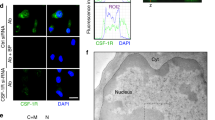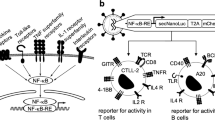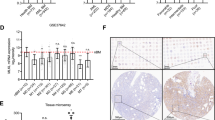Abstract
Expression of a receptor for human macrophage-colony stimulating factor (M-CSF or CSF-1), containing a point mutation which changes an aspartate to a valine at position 802 of the activating loop of the kinase domain, potently transforms the haemopoietic cell line FDC-P1 yet prevents Rat-2 fibroblast transformation. In order to understand this apparent paradox, aspartate 802 was changed by cassette mutagenesis to each of the other 19 amino acids. All hydrophobic amino acid substitutions were transforming when tested in FDC-P1 cells yet inactivating when tested in Rat-2 fibroblasts. These same amino acid substitutions also activated receptor degradation, strongly suggesting a causal relationship between receptor degradation and inactivation in fibroblasts. Point mutations or small deletions of Y708 within the kinase insert region of the mutant D802V receptor partly inhibited receptor degradation. The more stable D802V receptor derivatives were able to transform both FDC-P1 cells and Rat-2 fibroblasts, so establishing that the cell specific effect of the c-fmsD802V activating loop mutation is attributable to receptor degradation which accompanies kinase activation and prevents the transformation of Rat-2 but not of FDC-P1 cells.
This is a preview of subscription content, access via your institution
Access options
Subscribe to this journal
Receive 50 print issues and online access
$259.00 per year
only $5.18 per issue
Buy this article
- Purchase on Springer Link
- Instant access to full article PDF
Prices may be subject to local taxes which are calculated during checkout






Similar content being viewed by others
References
Baker DA, Maher J, Roberts IA and Dibb NJ. . 1994 Leukemia 8: 1970–1981.
Carlberg K, Tapley P, Haystead C and Rohrschneider L. . 1991 EMBO J. 10: 877–883.
Coussens L, Van Beveren C, Smith D, Chen E, Mitchell RL, Isacke CM, Verma I and Ullrich A. . 1986 Nature 320: 277–280.
De Bondt HL, Rosenblatt J, Jancarik J, Jones HD, Morgan DO and Kim SH. . 1993 Nature 363: 595–602.
Dibb NJ, Green SM and Ralph P. . 1990 Growth. Factors 2: 301–311.
Dubreuil P, Torres H, Courcoul MA, Birg F and Mannoni P. . 1988 Blood 72: 1081–1085.
Glover HR, Baker DA, Celetti A and Dibb NJ. . 1995 Oncogene 11: 1347–1356.
Hadwiger A, Niemann H, Kabisch A, Bauer H and Tamura T. . 1986 EMBO J. 5: 689–694.
Halenbeck R, Kawasaki E, Wrin J and Koths K. . 1989 Bio/Technology 7: 710–715.
Hopp TP and Woods KR. . 1981 Proc. Natl. Acad. Sci. USA 78: 3824–3828.
Hubbard S. . 1997 EMBO J. 16: 5573–5581.
Jeffrey PD, Russo AA, Polyak K, Gibbs E, Hurwitz J, Massague J and Pavletich NP . 1995 Nature 376: 313–320.
Johnson NL, Noble ME M and Owen DJ. . 1996 Cell 85: 149–158.
Kacinski BM. . 1997 Mol. Reprod. Dev. 46: 71–74.
Kitayama H, Kanakura Y, Furitsu T, Tsujimura T, Oritani K, Ikeda H, Sugahara H, Mitsui H, Kanayama Y, Kitamura Y and Matsuzawa Y. . 1995 Blood 85: 790–798.
Ladner MB, Martin GA, Noble JA, Nikoloff DM, Tal R, Kawasaki ES and White TJ. . 1987 EMBO. J. 6: 2693–2698.
Li W and Stanley ER. . 1991 EMBO J. 10: 277–288.
Mann R, Mulligan RC and Baltimore D. . 1983 Cell 33: 153–159.
Meier T, Arni S, Malarkannan S, Poincelet M and Hoessli D. . 1992 Anal. Biochem. 204: 220–226.
Minor Jr DL and Kim PS. . 1994 Nature 371: 264–267.
Nichols EJ, Manger R, Hakomori S, Hersovics A and Rohrschneider LR. . 1985 Mol. Cell Biol. 5: 3467–3475.
Novak U, Nice E, Hamilton JA and Pradiso L. . 1996 Oncogene 13: 2607–2613.
Piao X, Paulson R, Van Der Geer P, Pawson T and Bernstein A. . 1996 Proc. Natl. Acad. Sci. USA 93: 14665–14669.
Rambaldi A, Wakamiya N, Vellenga E, Horiguchi J, Warren MK, Kufe D and Griffin JD. . 1988 J. Clin. Invest. 81: 1030–1035.
Reedijk M, Liu XQ and Pawson T. . 1990 Mol. Cell Biol. 10: 5601–5608.
Reedijk M, Liu X, Van Der Geer P, Letwin K, Waterfield MD, Hunter T and Pawson T. . 1992 EMBO J. 11: 1365–1372.
Rettenmier CW, Roussel MF, Ashmun RA, Ralph P, Price K and Sherr CJ. . 1987 Mol. Cell Biol. 7: 2378–2387.
Rohrschneider LR and Metcalf D. . 1989 Mol. Cell Biol. 9: 5081–5092.
Roth P and Stanley ER. . 1992 Curr. Top. Microbiol. Immunol. 181: 141–167.
Roussel MF, Rettenmier CW, Look AT and Sherr CJ. . 1984 Mol. Cell Biol. 4: 1999–2009.
Roussel MF, Downing JR, Rettenmier CW and Sherr CJ. . 1988 Cell 55: 979–988.
Sambrook J, Fritsch EF and Maniatis T. . 1989 Molecular Cloning: A Laboratory Manual 2nd Ed., Cold Spring Harbor Laboratory, Cold Spring Harbor, New York.
Sherr CJ, Rettenmier CW, Sacca R, Roussel MF, Look AT and Stanley ER. . 1985 Cell 41: 665–676.
Smith CK, Withka JM and Regan L. . 1994 Biochemistry 33: 5510–5517.
Songyang Z, Carraway KL, Eck MJ, Harrison SC, Feldman RA, Mohammadi M, Schlessinger J, Hubbard SR, Smith DP, Eng C, Lorenzo MJ, Ponder BAJ, Mayer BJ and Cantley LC. . 1995 Nature 373: 536–539.
Stanley ER, Berg KL, Einstein DB, Lee PS, Pixley FJ, Wang Y and Yeung YG. . 1997 Mol. Reprod. Dev. 46: 4–10.
Tavormina PL, Shiang R, Thompson LM, Zhu YZ, Wilkin DJ, Lachman RS, Wilcox WR, Rimion DL, Cohn DH and Wasmuth JJ. . 1995 Nat. Genet. 9: 321–328.
Trouliaris S, Hadwiger-Fangmeier A, Heimann M and Tamura T. . 1995 Arch. Virol. 140: 179–186.
Tsujimura T, Furitsu T, Morimoto M, Kanayama Y, Nomura S, Matsuzawa Y, Kitamura Y and Kanakura Y. . 1995 Int. Arch. Allergy. Immunol. 106: 377–385.
van der Geer P and Hunter T. . 1991 Mol. Cell Biol. 11: 4698–4709.
van Der Geer P and Hunter T. . 1993 EMBO J. 12: 5161–5172.
Veron M, Radzio Andzelm E, Tsigelny I, Ten Eyck LF and Taylor SS. . 1993 Proc. Natl. Acad. Sci. USA 90: 10618–10622.
Wheeler EF, Askew D, May S, Ihle JN and Sherr CJ. . 1987 Mol. Cell Biol. 7: 1673–1680.
Acknowledgements
We thank Chiron for providing M-CSF and Stephen Dilworth for his expert advice and help. We also thank John White for many useful discussions. This work was funded in part by the BBSRC. GMM and MU were recipients of Medical Research Council and Cancer Research Campaign studentships.
Author information
Authors and Affiliations
Rights and permissions
About this article
Cite this article
Morley, G., Uden, M., Gullick, W. et al. Cell specific transformation by c-fms activating loop mutations is attributable to constitutive receptor degradation. Oncogene 18, 3076–3084 (1999). https://doi.org/10.1038/sj.onc.1202646
Received:
Revised:
Accepted:
Published:
Issue Date:
DOI: https://doi.org/10.1038/sj.onc.1202646
Keywords
This article is cited by
-
CSF1R mutations in hereditary diffuse leukoencephalopathy with spheroids are loss of function
Scientific Reports (2013)
-
Comparison of nilotinib and imatinib inhibition of FMS receptor signaling, macrophage production and osteoclastogenesis
Leukemia (2008)
-
FMS receptor for M-CSF (CSF-1) is sensitive to the kinase inhibitor imatinib and mutation of Asp-802 to Val confers resistance
Oncogene (2006)
-
Switching on kinases: oncogenic activation of BRAF and the PDGFR family
Nature Reviews Cancer (2004)
-
The role of FLT3 in haematopoietic malignancies
Nature Reviews Cancer (2003)



